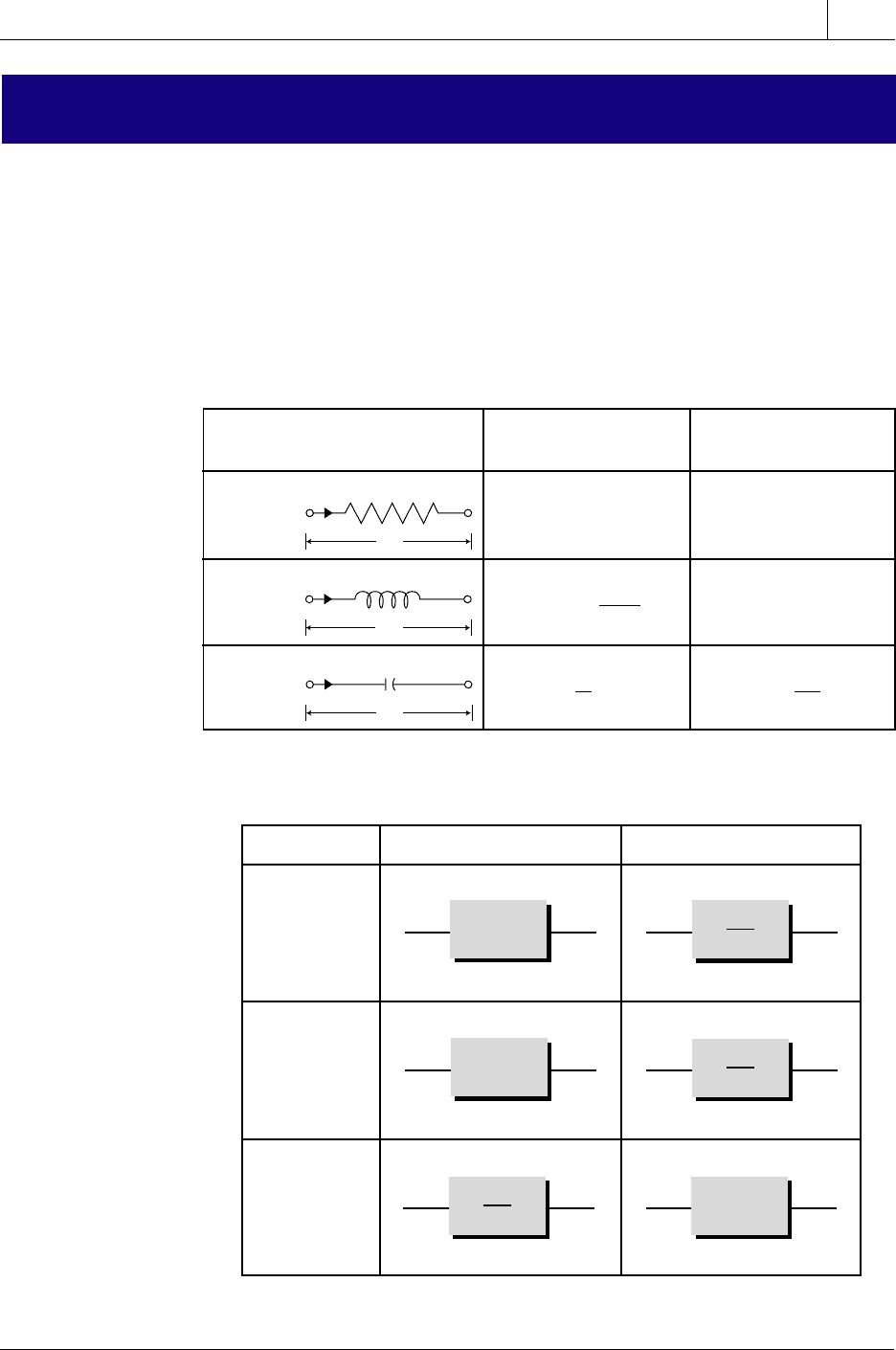Bryan L. Programmable controllers. Theory and implementation
Подождите немного. Документ загружается.


999
APPENDIX
G
Voltage-Current Laplace
Transfer Function Relationships
Industrial Text & Video Company 1-800-752-8398
www.industrialtext.com
APPENDIX G: VOLTAGE-CURRENT LAPLACE TRANSFER
FUNCTION RELATIONSHIPS
Table G-1 presents resistor, inductor, and capacitor voltage-current relationships
and their corresponding Laplace equations. Note that the inductor voltage is a
derivative term of the current, while the capacitor voltage is an integral term of the
current. Table G-2 illustrates these same relationships in system block diagram
form. In this table, if the current is the input to the resistor block transfer function, the
result is the voltage (
I
R
(
s
)
×
R
=
V
R
(
s
)
). The same holds true for the derivative block
transfer function of an inductor and the integral block transfer function of a capacitor.
If the voltage is the input, the output of each transfer function will be the current.
Table G-1. Voltage-current Laplace transfer function relationships.
Table G-2. Block diagrams of transfer functions.
Element and Representation
Voltage-Current
Relationship
Laplace Transform
Relationship
Resistor
Inductor
Capacitor
Resistor
Inductor
Capacitor
Current Input
Voltage Input
R
I
R(s)
V
R(s
)
Ls
I
L(s)
V
L(s
)
1
Cs
I
C(s)
V
C(s
)
1
R
V
R(s)
I
R(s)
1
Ls
V
L(s)
I
L(s)
Cs
V
C(s)
I
C(s)
C
i
C
v
C
L
i
L
v
L
R
i
R
v
R
vRi
Rt Rt
() ()
=
VRI
Rs Rs
() ()
=
vL
di
dt
Lt
Lt
()
()
=
V LsI
Ls Ls
() ()
=
v
C
idt
Ct Ct
t
() ()
=
∫
1
0
V
Cs
I
Cs Cs
() ()
=
1
Industrial Text & Video Company 1-800-752-8398
www.industrialtext.com
This page intentionally left blank.

1001
Glossary
Industrial Text & Video Company 1-800-752-8398
www.industrialtext.com
G
LOSSARY
AC/DC I/O interface. A discrete interface that converts alternating current (AC)
voltages from field devices into direct current (DC) signals that the processor can
use. It can also convert DC signals into proportional AC voltages.
action. A set of control instructions prompting a PLC to perform a certain control
function during the execution of a sequential function chart step.
acyclic message. An unscheduled message transmission.
A/D. See analog-to-digital converter.
address. (1) The location in a computer’s memory where particular information is
stored. (2) The alphanumeric value used to identify a specific I/O rack, module
group, and terminal location.
addressability. The total number of devices that can be connected to a network.
address field. The sequence of eight (or any multiple of eight) bits immediately
following the opening flag sequence of a frame, which identifies the secondary
station that is sending (or is designated to receive) the frame.
AI. See artificial intelligence.
algorithm. A set of procedures used to solve a problem.
alphanumeric code. A character string consisting of a combination of letters,
numbers, and/or special characters used to represent text, commands, numbers,
and/or code groups.
ambient temperature. The temperature of the air surrounding a device.
American National Standards Institute (ANSI). A clearinghouse and coordinat-
ing agency for voluntary standards in the United States.
American Wire Gauge (AWG). A standard system used to designate the size of
electrical conductors. Gauge numbers have an inverse relationship to size; larger
gauges have a smaller diameter.
analog device. An apparatus that measures continuous information signals (i.e.,
signals that have an infinite number of values). The only limitation on resolution
is the accuracy of the measuring device.
analog input interface. An input circuit that uses an analog-to-digital converter to
translate a continuous analog signal, measured by an analog device, into a digital
value that can be used by the processor.
analog output interface. An output circuit that uses a digital-to-analog converter to
translate a digital value, sent from the processor, into an analog signal that can
control a connected analog device.
analog signal. A continuous signal that changes smoothly over a given range, rather
than switching suddenly between certain levels as discrete signals do.
analog-to-digital converter (A/D). A device that translates analog signals from
field devices into binary numbers that can be read by the processor.
AND. A logical operator that requires all input conditions to be logic 1 for the output
to be logic 1. If any input is logic 0, then the output will be logic 0.
ANSI. See American National Standards Institute.
A

1002
Glossary
Industrial Text & Video Company 1-800-752-8398
www.industrialtext.com
application. (1) A machine or process monitored and controlled by a PLC. (2) The
use of computer or processor-based routines for specific purposes.
application memory. The part of the total system memory devoted to storing the
application program and its associated data.
application program. The set of instructions that provides control, data acquisition,
and report generation capabilities for a specific process.
arithmetic instructions. Computer programming codes that give a PLC the ability
to perform mathematical functions, such as addition, subtraction, multiplication,
division, and square root, on data.
artificial intelligence (AI). A subfield of computer science dealing with the
development of computer programs that solve tasks requiring extensive knowl-
edge.
ASCII. For American Standard Code for Information Interchange. A seven-bit code
with an optional parity bit used to represent alphanumeric, punctuation, and
control characters.
ASCII I/O interface. A special function interface that transmits alphanumeric data
between peripheral equipment and a PLC.
assembly language. A symbolic programming language that can be directly
translated into machine language instructions.
asynchronous. Recurrent or repeated operations that occur in unrelated patterns
over time.
AWG. See American Wire Gauge.
back plane. A printed circuit board, located in the back of a chassis, that contains
a data bus, power bus, and mating connectors for modules that will be inserted into
the chassis.
backup. A device or system that is kept on hand to replace a device or system that
fails.
backward chaining. A method of finding the causes of an outcome by analyzing its
consequents to obtain its antecedents.
bandwidth. The range of frequencies expressed in Hertz over which a system is
designed to operate.
base. The maximum number of digits used to represent values in a number system.
baseband coaxial cable. A communication medium that can send one transmission
signal at a time at its original frequency.
BASIC module. An intelligent I/O interface capable of performing computational
tasks without affecting the PLC processor’s computing time.
battery backup. A battery or set of batteries that will provide power to the
processor’s memory in the event of a power outage.
baud. (1) The reciprocal of the shortest pulse width in a data communication stream.
(2) The number of binary bits transmitted per second during a serial data
transmission.
Baye’s theorem. An equation that defines the probability of one event occurring
based on the fact that another event has already occurred.
BCC. See block check character.
B

1003
Glossary
Industrial Text & Video Company 1-800-752-8398
www.industrialtext.com
BCD. See binary coded decimal.
binary coded decimal (BCD). A binary number system in which each decimal digit
from 0 to 9 is represented by four binary digits (bits). The four positions have a
weighted value of 1, 2, 4, and 8, respectively, starting from the least significant
(right-most) bit.
binary number system. A base 2 number system that uses only the numbers 0 and
1 to express all values. Each digit position of a binary number has a weighted value
of 1, 2, 4, 8, 16, 32, 64, and so on, starting with the least significant (right-most)
digit.
bit. For binary digit. The smallest unit of binary information. A bit can have a value
of 1 or 0.
bit rate. See baud.
bit-wide bus network. An I/O bus network that interfaces with discrete devices that
transmit less than 8 bits of data at a time.
blackboard architecture. The distribution of knowledge inferencing, as well as
global and knowledge databases, in a control system through the use of several
subsystems containing local, global, and knowledge databases that work indepen-
dently of each other.
block. A group of words transmitted as a unit.
block check character (BCC). A character, placed at the end of a data block, that
corresponds to the characteristics of the block.
block diagram. A schematic drawing.
block length. The total number of words transmitted at one time.
block transfer. A programming technique used to transfer up to 64 words of data to
or from an intelligent I/O module.
Boolean action. A set of control instructions that assigns a discrete value to a
variable during a sequential function chart step.
Boolean language. A PLC programming language, based primarily on the Boolean
logic operators, that implements all of the functions of the basic ladder diagram
instruction set.
Boolean operators. Logical operators, such as AND, OR, NAND, NOR, NOT, and
exclusive-OR, that can be used singly or in combination to form logical statements
that have output responses of TRUE or FALSE.
Boolean variable. A single-bit variable whose value is transmitted in the form of 1s
and 0s.
Bourdon tube. A pressure transducer available in spiral, helical, twisted, and C-tube
configurations that converts pressure measurements into displacement.
branch. A parallel logic path within a rung.
breadth-first search. A method of rule evaluation that evaluates each rule in the
same level of a decision tree before proceeding downward.
bridge circuit. A mechanism found in transducer circuits that uses resistors to
change the parameters (e.g., voltage and current) of an incoming signal.
broadband coaxial cable. A communication medium that can transmit two or more
transmission signals at one time via frequency division multiplexing.
burn-in procedure. The process of operating a device at an elevated temperature to
identify early-failing parts.

1004
Glossary
Industrial Text & Video Company 1-800-752-8398
www.industrialtext.com
bus. (1) A group of lines used for data transmission or control. (2) Power distribution
conductors.
bus topology. A network configuration in which all stations are connected in parallel
with the communication medium and all stations can receive information from any
other station on the network.
bypass/control station. A device that allows a process to be switched to either PLC
or manual control.
byte. A group of eight adjacent bits that are operated on as a unit, such as when
moving data to or from memory.
byte-wide bus network. An I/O bus network, which interfaces with discrete and
small analog devices, that can transmit between 1 and 50 or more bytes of data at
a time.
cascade control. The use of two controllers to regulate a process so that the feedback
loop of one controller is the set point of the other controller.
center of gravity method. A method of calculating the final output value of a fuzzy
logic controller by finding the value that corresponds to the center of the mass
under the control output curve.
centralized control. A PLC control system organization in which a central PLC
controls several machines or processes.
central processing unit (CPU). The part of a programmable controller responsible
for reading inputs, executing the control program, and updating outputs. Some-
times referred to as the processor, the CPU consists of the arithmetic logic unit,
timing/control circuitry, accumulator, scratch pad memory, program counter,
address stack, and instruction register.
centroid. The point in a geometrical figure whose coordinates equal the average of
all the other points comprising the figure.
channel. A designated path for a signal.
channel capacity. The amount of information that can be transmitted per second on
a given communication channel depending on the medium, line length, and
modulation rate.
character. One symbol of a set of elementary symbols, such as a letter of the alphabet
or a number.
chassis. A hardware assembly that houses PLC devices, such as I/O modules,
adapter modules, processor modules, power supplies, and processors.
checksum. A transmission verification algorithm that adds the binary values of all
the characters in a data block and places the sum in the block check character
position.
chip. A very small piece of semiconductor material that holds electronic compo-
nents. Chips are normally made of silicon and are typically less than 1/4 inch
square and 1/100 inch thick.
closed loop. A control system that uses feedback from the process to maintain
outputs at a desired level.
coaxial cable. A transmission medium, consisting of a central conductor surrounded
by dielectric materials and an external conductor, that possesses a predictable
characteristic impedance.
C

1005
Glossary
Industrial Text & Video Company 1-800-752-8398
www.industrialtext.com
code. (1) A binary representation of numbers, letters, or symbols that have some
meaning. (2) A set of programmed instructions.
coil. A ladder diagram symbol that represents an output instruction.
cold junction compensation. A compensation factor that allows a thermocouple to
operate as though it has an ice-point reference.
collision detection (CSMA/CD). A network access method in which each node
waits until there is no traffic on the network then transmits its message. If the node
detects another transmission on the network, it will disable its transmitter and wait
until the network clears before retransmitting the message.
combined error. See propagation error.
common bus topology. A network configuration in which individual PLCs connect
to a main trunkline in a multidrop fashion.
compatibility. (1) The ability of various specified units to replace one another with
little or no reduction in capability. (2) The ability of units to be interconnected and
used without modification.
complement. A logical operation that inverts a signal or bit.
conditional probability inferencing. The conditional probability of an event
happening in an artificial intelligence system.
constant voltage transformer. A transformer that maintains a steady output voltage
(secondary) regardless of input voltage (primary) fluctuations.
contact. A ladder diagram symbol that represents an input condition.
contact output interface. A discrete interface, which does not require an external
power source, that is triggered by the change in state of a normally open or
normally closed contact.
contact symbology. A set of symbols used to express a control program through
conventional relay symbols (e.g., normally open contacts, normally closed con-
tacts, etc.).
continuous-mode controller. A process controller that sends an analog signal to a
process control field device.
control element. The output field device that regulates the actual control variable
level in a process control system.
control logic. The control plan for a given system.
control loop. The method of adjusting the control variable in a process control
system by analyzing process variable data and then comparing it to the set point
to determine the amount of error in the system.
control panel. A panel that contains instruments used to control devices.
control program checkout. A final review of a PLC’s control program prior to
starting up the system.
control program printout. A hard copy of the control logic program stored in a
PLC’s memory.
control strategy. The sequence of steps that must occur during a process or PLC
program to produce the desired output control.
control task. The desired results of a control program.
control variable. The independent variable in a process control system that is used
to adjust the dependent variable, the process variable.

1006
Glossary
Industrial Text & Video Company 1-800-752-8398
www.industrialtext.com
convergence. A point in a sequential function chart where many elements flow into
one element.
counter. An electromechanical device that counts the number of times an event
occurs.
counter instructions. Computer programming codes that allow a PLC to perform
the counting functions (count up, count down, counter reset) of a hardware counter.
CPU. See central processing unit.
CRC. See cyclic redundancy check.
critically damped response. A second-order control system response in which the
damping coefficient equals 1, causing the response to overshoot the set point and
then quickly settle back to it.
CSMA/CD. See collision detection.
current loop. A two-wire communication link in which the presence of a 20
milliamp current level indicates a binary 1 (mark) and its absence indicates no data,
a binary 0 (space).
CX-ORC. See cyclic exclusive-OR checksum.
cyclic exclusive-OR checksum (CX-ORC). An error detection method in which the
words in the data block are exclusive-ORed with the checksum word and then
rotated to the left. This action is repeated until all of the words in the block have
been operated on.
cyclic message. A scheduled message transmission.
cyclic redundancy check (CRC). An error detection method in which all the bits
in a block are divided by a predetermined binary number. The remainder becomes
the block check character.
D/A. See digital-to-analog converter.
data. A general term for any type of information.
data link layer. Layer 2 of the OSI network protocol. This layer provides functional
and procedural means for establishing, maintaining, and releasing data link
connections among network entities.
data manipulation instructions. Computer codes that provide a PLC with the
ability to compare, convert, shift, examine, and operate on data in multiple
registers.
data table. The part of a processor’s memory, containing I/O values and files, where
data is monitored, manipulated, and changed for control purposes.
data transfer instructions. Computer codes that allow a PLC to move numerical
data within a controller, either in single register units or in blocks of registers.
DC I/O interface. A discrete module that links a processor with direct current field
devices.
dead time. The delay between the time a control system’s control variable changes
and the time the process variable begins to respond to the change.
debouncing. The act of removing intermediate noise from a mechanical switch.
decimal number system. A base 10 number system that uses ten numbers—0, 1, 2,
3, 4, 5, 6, 7, 8, and 9—to represent all values. Each digit position has a weighted
value of 1, 10, 100, 1000, and so on, beginning with the least significant (right-
most) digit.
D

1007
Glossary
Industrial Text & Video Company 1-800-752-8398
www.industrialtext.com
defuzzification. The process of converting a fuzzy logic controller’s output conclu-
sions into real output data and sending the data to the field device.
depth-first search. A rule evaluation method that evaluates all the rules in a
downward branch of a decision tree before proceeding to the next branch.
derivative controller. A continuous-mode controller whose output to the control
field device is proportional to the rate of change of error in the system.
device bus network. A network that allows low-level input/output devices that
transmit relatively small amounts of information to communicate directly with a
PLC.
diagnostic AI system. The lowest level of artificial intelligence system. This type
of system primarily detects faults within an application but does not provide
information about possible solutions.
diagnostics. The detection and isolation of an error or malfunction.
differential input/output. A signal transmission system where inputs and outputs
have individual return lines for each channel, as opposed to all data running
through one line.
digital device. A device that processes and sends discrete (two-state) electrical
signals.
digital signal. A noncontinuous signal that has a finite number of values.
digital-to-analog converter (D/A). A device that translates binary numbers from a
processor into analog signals that field devices can understand.
direct-acting controller. A closed-loop controller whose control variable output
increases in response to an increase in the process variable.
direct action I/O interface. A special I/O interface that detects, preprocesses, and
transmits low-level and fast-speed signals.
discrete input interface. An input circuit that allows a PLC to receive data from
digital field devices.
discrete-mode controller. A controller that sends a noncontinuous signal to the field
device controlling a process.
discrete output interface. An output circuit that allows a PLC to send data to digital
field equipment.
displacement transducer. A device that measures the movement of an object.
distributed control. A PLC control system organization in which factory or
machine control is divided into several subsystems, each managed by a separate
PLC, yet all interconnected to form a single entity.
distributed I/O processing. The allocation of various control tasks to several
intelligent I/O interfaces.
divergence. A point in a sequential function chart where one element flows into
many elements.
documentation. An orderly collection of recorded hardware and software informa-
tion about a control system. These records provide valuable reference data for
installing, debugging, and maintaining the PLC.
double-precision arithmetic. Arithmetic instructions that use double the number of
registers than single-precision arithmetic to hold the operands and result (i.e., two
registers each for the operands and two or four registers for the result).
downtime. The time when a system is not available for use.

1008
Glossary
Industrial Text & Video Company 1-800-752-8398
www.industrialtext.com
dynamic system checkout. The process of verifying the correct operation of a
control program by actually implementing it.
EAROM. See electrically alterable read-only memory.
EEPROM. See electrically erasable programmable read-only memory.
EIA. See Electronic Industries Association.
electrically alterable read-only memory (EAROM). A type of nonvolatile,
programmable, read-only memory that can be erased completely by applying the
proper voltage to the memory chip.
electrically erasable programmable read-only memory (EEPROM). A type of
nonvolatile, programmable, read-only memory that can be erased by electrical
pulses.
Electronic Industries Association (EIA). An agency that sets electrical/electronic
standards.
encoder/counter module. An interface, which is used in positioning applications,
that links encoders and high-speed counter devices with programmable logic
controllers.
enhanced ladder language. A PLC language that implements basic ladder language
instructions, as well as more sophisticated functional block instructions, which can
perform multiple operations in a single instruction.
EPROM. See erasable programmable read-only memory.
erasable programmable read-only memory (EPROM). A type of nonvolatile,
programmable, read-only memory that can be erased with ultraviolet light.
error. The difference between the set point and the process variable in a control
system.
error-correcting code. A code in which each acceptable expression conforms to
specific rules of construction that also define one or more nonacceptable expres-
sions, so that if certain errors occur, they can be detected and corrected.
error deadband. The amount that the process variable can fluctuate from the set
point before the control system provides corrective action.
error-detecting code. A code in which each expression conforms to specific rules
of construction, so that if an error occurs in an expression, it can be detected.
exclusive-OR (XOR). A logical operation, which has only two inputs, that yields a
logic 1 output if only one of the two inputs is logic 1 and a logic 0 output if both
inputs are the same, either logic 1 or logic 0.
execute. To perform a specific operation by processing either one instruction, a
series of instructions, or a complete program.
execution time. The time required to perform one specific instruction, a series of
instructions, or a complete program.
executive memory. The part of the system memory that permanently stores a
system’s supervisory programs, as well as instruction software. This area of
memory is not accessible to the user.
expert AI system. The highest level of AI systems. This type of system detects
process faults, provides information about possible causes of the faults, and makes
complex decisions about resulting actions based on statistical analysis.
E
